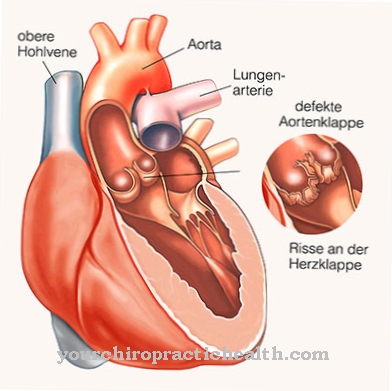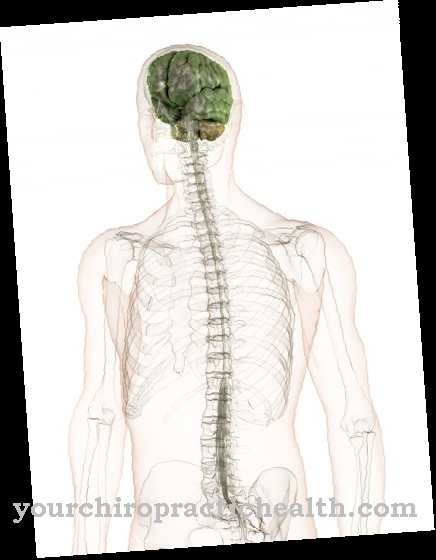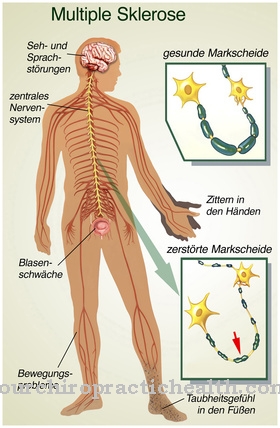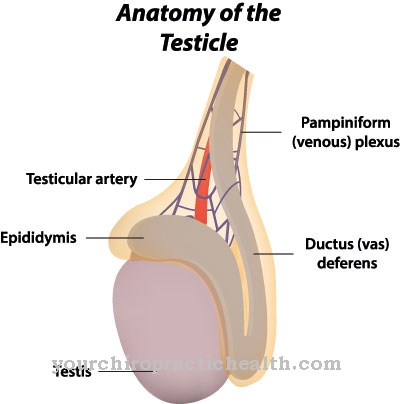Progeny is a jaw disease. In this case, it is defective (dysgnathia). A reverse overbite of the incisors (so-called frontal cross bite) is characteristic of a progeny.
What is progeny?

© Anatomy Insider - stock.adobe.com
With the term Progeny In dentistry, a massive misalignment of the jaw is called. Since the term is increasingly perceived as misleading because it only describes a protruding chin, the term is primarily used in the new literature Dysgnathia.
The progeny is classified as a subset of the various dysgnathias. A reverse overbite (also called frontal crossbite) is characteristic of this jaw malposition. The incisors in particular are in an unusual position. The progeny is usually not limited to the teeth, but extends to the entire jaw.
A progeny can consequently result in various impairments of functionality. Damage to other parts of the lower skull area is also conceivable.
causes
A progeny cannot usually be traced back to a single cause. This means that it usually has more than one cause. In the dental literature, however, a large role is attributed to genetics. A dysgnathia can therefore be inherited dominantly.
In addition, however, further development incentives are shown that can lead to the development of a jaw misalignment such as progeny. These include, for example, functional disorders of the tongue (so-called dyskinesia) or deviations from the regular body structure (morphological anomalies).
Morphological abnormalities that can lead to the development of a progeny include, for example, an enlarged tongue or a severely restricted breathing ability of the nose, which leads to almost complete breathing through the mouth. All of these are factors that can cause the jaw to fail to grow and thus lead to progeny.
Cleft lip and palate should also be considered. The resulting scars can inhibit jaw growth. In summary, the most common causes of progeny are heredity (genetics), functional disorders of the tongue (dyskinesias), morphological abnormalities (e.g. reduced breathing ability of the nose) and scars that are the result of a cleft lip and palate.
Symptoms, ailments & signs
A progeny primarily has visual effects. This means that the misalignment of the jaw is visible to the naked eye (often also for the layperson). Often the jaw shifts forward so that the lips cannot be completely closed.
The lower lips are shifted forward compared to the upper lip. The facial areas of many affected people appear concave and the nasolabial fold is noticeably deepened. Complaints caused by a progeny (dysgnathia) are (among others): Difficulty chewing or speaking, pain in the entire jaw area and reduced breathing ability of the nose.
Diagnosis & course of disease
Dentists make the diagnosis of progeny purely visually. The typical features of the face are observed and evaluated. This determines the degree or severity of the misalignment. Since in maxillofacial surgery a distinction is made between real and real progeny, an exact distinction between the two manifestations is often made during a diagnosis.
While the real progeny is characterized by an overdevelopment of the lower jaw, the false progeny is characterized by an underdeveloped upper jaw. Underdevelopments of the middle face are also assigned to the false progeny. Mixed forms are also possible. X-rays can therefore also be carried out for precise delimitation. This enables a more detailed examination.
When should you go to the doctor?
If there are irregularities in the position of the teeth or jaws in the child's growth and development process, a doctor should be consulted. An overbite of the teeth in the frontal area is characteristic of progeny. If the incisors of the upper and lower jaw are not correctly aligned, the observations can be discussed with a doctor. In principle, however, a regular check-up visit to a doctor should take place in advance. This enables rapid intervention if changes or abnormalities appear in the jaw area. If there are serious disturbances in development, a quick correction can be initiated in these cases within the growth process. Therefore, parents or legal guardians should visit a dentist with the children at least twice a year.
If problems arise during the chewing process or if there is a speech impairment due to the impairment, a doctor should be consulted. Pain, swelling or swallowing disorders should be examined and treated.
Those affected who do not perceive any impairment despite the prognosis should decide for themselves whether the postponements are a reason to see a doctor. In some cases it is an optical flaw that does not require any medical attention. If the person concerned or the guardian does not want explicit treatment, no further steps need to be taken.
Treatment & Therapy
Jaw misalignments such as progeny or dysgnathia can be treated in different ways. Following a comprehensive diagnosis that differentiates between real and fake dysgnathia, the possible forms of treatment are discussed. Various therapy options are available, depending on the age of the patient or the severity of the disease.
For example, it is possible to use special devices that have to be worn continuously over a longer period of time. This can improve the misalignment of the jaw in a conservative way by up to five millimeters. However, this method is considered to be quite tedious and painful. The treatment is also conservative with specially made braces.
This shifts the lower rows of teeth (dental compensation of the lower jaw). An operation is also conceivable, especially in difficult cases. Here the upper and lower jaw are surgically adjusted. Often corrections to the side view of the face are also made. The costs are covered by the health insurance companies if there is an indication.
You can find your medication here
➔ Toothache medicationprevention
Jaw misalignments can best be prevented through early detection of morphological deviations. Much can be achieved in a conservative way in childhood. The development of a complete progeny or dysgnathia can possibly still be prevented.
This can make dental compensation of the lower jaw or surgical treatment unnecessary. It is therefore advisable to bring children for dental examinations at an early stage. The treating dentist will notice misalignments of the jaw, so that conservative therapy can be started at an early stage.
Aftercare
In the case of a progeny, those affected usually have only a few and usually only limited follow-up measures available.Those affected should therefore consult a doctor at the first symptoms of this disease, so that there are no complications or other complaints in the further course. An early diagnosis with subsequent treatment usually has a very positive effect on the further course of the disease.
Most patients are reliant on a surgical procedure during progeny, through which the symptoms can be relieved permanently. After such an operation, strict bed rest should be maintained, with no exertion or physical and stressful activities. In general, a healthy lifestyle with a healthy diet can have a very positive effect on the further course of the disease.
Even after a successful surgical procedure, regular checkups and examinations by a doctor are very important in order to monitor the current state of the progeny. As a rule, this disease does not reduce the patient's life expectancy. The further course depends strongly on the time of diagnosis, so that a general prediction is usually not possible.
You can do that yourself
People who suffer from a misalignment of the jaw should check carefully whether a change is medically necessary or whether it is just a visual flaw. If the movements of the jaws are minimal and the chewing process is not impaired, often no correction is required. This means that the person affected should build up his self-confidence so as not to experience any emotional irregularities in everyday life.
With a trained progeny there are abnormalities in the voice. The pronunciation is unclean and can be practiced independently by the patient. In therapy, various exercises are practiced to improve vocalization. These exercises can be repeated independently several times a day so that an improvement occurs.
If the food cannot be grinded sufficiently due to the misalignment and the gaps between the teeth, the food intake must be changed. The components of the meals should be crushed into smaller pieces before they are fed to the mouth. This avoids complications and supports the act of swallowing. Swallowing and digestive disorders should be avoided.
Despite the disease, teeth should be cleaned sufficiently daily. This is more difficult in patients with braces. Nevertheless, care must be taken to ensure that food is removed twice a day and that no deposits form on the tongue

.jpg)




.jpg)




















